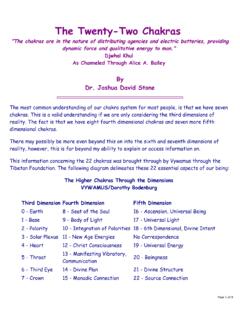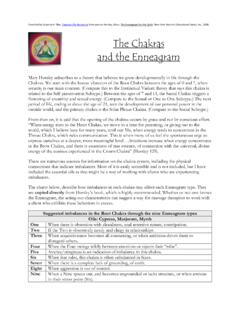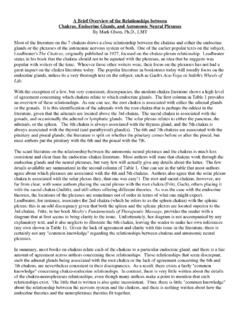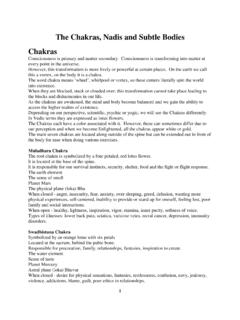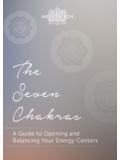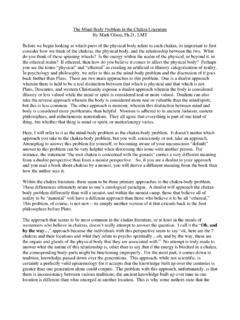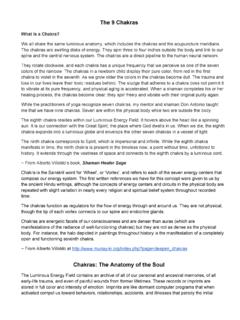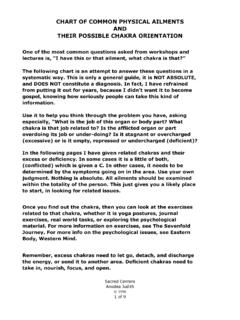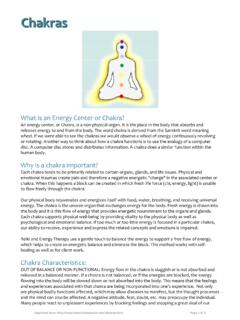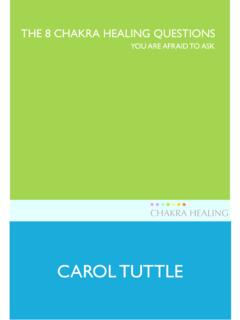Transcription of The Chakras - Kundalini Awakening Systems 1
1 The Chakras Each of the Chakras has "basic rights," "identities," and "demons" associated with it. Basic rights are defined as the basic inalienable right associated with each chakra . Loss of these rights blocks the chakra . Reclaiming these rights is a necessary part of healing the chakra . Identities: If our rights remain intact, or if we have managed to reclaim them, then we have a good chance at embracing our seven basic chakra identities, each of which builds upon the one below in an ever expanding pattern of larger Systems . The identities can be seen as metaphoric layers of clothing, as ways to cover the essential soul underneath. It is not a problem to have clothing we need different outfits for different occasions. It is a problem if we think the clothing is who we actually are, and never remove it. When we are so immersed in these identities that we confuse them with the underlying Self, then we have gotten stuck at a particular level. We have confused the clothing for the body itself unwilling to remove it, scared to expose the nakedness underneath.
2 If, on the other hand, we cannot identify at all with a level, then we know we have some work to do there. The chakra identities can be positive or negative, liberating or imprisoning. They are simultane ously real and false. They are real in that they are real parts, yet they are false because they are not the whole. Demons: Each of the Chakras has what I have come to call a specific demon that interferes with its health and undermines its identity. I use the word demon not to denote some kind of evil creature, but as a way of naming the counterforce that seemingly opposes the natural activity of the chakra . The reason I say seemingly is that the demons arise to teach us something. A counterforce usually results in strengthening whatever it opposes. The presence of the demon keeps the chakra from doing its job, but that challenge also forces us to bring more awareness to that job, so eventually we can do it better. When unacknowledged, the demons keep us from moving forward.
3 They fixate our energy at a particular chakra level, short circuiting our activities and expression, blocking resolution. If we acknowledge the demon and explore its reason for being there, we gain a deeper understanding of ourselves. To acknowledge that we have fear, for example, enables us to face that fear and understand its origins, eventually making us more confident. To acknowledge grief enables healing, and allows the heart to lighten. Reprinted for Kundalini Awakening Systems 1. 1 From: Eastern Body, Western Mind by Anodea Judith. First chakra "If you're an alive body, no one can tell you how to experience the world. And no one can tell you what truth is, because you experience it for yourself. The body does not lie." Stanley Keleman Name: Muladhara/Root Element: Earth Purpose: Foundation Issues: Roots, Grounding, Nourishment, Trust, Health, Home, Family, Prosperity, Appropriate Boundaries Color: Red Location: Base of Spine, Coccygeal Plexus Orientation: Self Preservation Archetype: Earth Mother Basic Right: To Be Here and Have To find solidity in the first chakra , we must have an instinctual sense of our right to be here.
4 Without the right to be here, few other rights can be reclaimed. Do we have the right to take up space? Do we have the right to establish individuality? Do we have the right to take care of ourselves? The right to be here is our right to exist the right that is the foundation of our survival and security. Affirmations: "It is safe for me to be here." "The earth supports me and meets my needs." "I love my body and trust its wisdom." "I am immersed in abundance." "I'm here and I'm real." Identity: Our first identity level is known as the physical identity, and its job is self preservation. Here we learn to identify with the body when my body is hungry, I am hungry, when it hurts, I hurt. The body cloaks the invisible soul, and reveals its shape and expression. When we identify with the body, we identify with the soul's expression in physical form, as well as its physical qualities of male, female, young, old, fat, thin, healthy, or sick. Physical identification is necessary for dealing with the physical world.
5 If I do not realize that I cannot lift one hundred pounds of paper in a carton, I can seriously hurt my back. If I do not re cognize when I am hungry or need to rest, I can seriously compromise my health over time. To go without this identity is to be dissociated from the body and disconnected from the physical world. Reprinted for Kundalini Awakening Systems 1. 2 From: Eastern Body, Western Mind by Anodea Judith. Demon: Fear When survival is threatened, we feel afraid. Fear heightens our awareness and floods the body with natural chemicals (such as adrenalin) to energize it for action. Fear brings our attention into the here and now to address the threat, but focuses the attention outward and upward to the Chakras of perception and mental activity. We become hypervigilant, restless, anxious. We cannot settle, relax, or let down. It is as if we are jumping right out of our skins. Although fear is the demon of the first chakra , it is also a sacred adversary, a presence that has much to teach us.
6 Fear exists as an ally of self preservation, teaching us of our own importance and the need to take care of ourselves. Only when we acknowledge this demon as an ally can it betruly mastered. Ernest Holmes, who founded the Science of Mind philosophy, describes both qualities of fear and faith as having similar qualities. Fear is a belief that something awful might happen, while faith is a belief that something good will happen. Although the results are different, the causes are the same both are beliefs that govern our behavior and influence the way we feel. If we can replace unreasonable fear with reasonable faith, then we have a natural antidote to our first chakra demon. Reclaiming the Temple of the Body The Foundation of the Temple All foundations rest upon the earth the universal ground for all that we do. Our bodies are the earth of our spirit, the foundation, the home. To connect with the body is to connect with the earth, to be grounded in the biological reality of existence.
7 Situated at the base of the spine, the first chakra is the foundation for the entire chakra system. It is here we build the foundation for the entire chakra system. It is here we build the foundation for the temple of the body the anchor for the Rainbow Bridge. Without a strong, rooted founda tion, little else can be accomplished. We must have soil firm enough to provide stability, yet yielding enough to be penetrated by roots. The anchoring of this temple digs deep into the earth, for its Sanskrit name, muladhara, means root. The foundation contains the temple's energy by defining its scope, edges, and boundaries. It defines a place, as a basic context of all that happens to us. It gives us a ground, a home, an anchor point for our experience. The foundation largely determines the shape of the structure above, determining what it can hold, how high it can build, what kind of stresses it can with stand. Thus damage to this chakra is reflected in each and every chakra above.
8 To build a strong foundation is to gain solidity. Solidity allows us to be firm and make boundaries. Solidity has consistency, repetition, accountability. Our bodies are the solid form of our existence; they have definable boundaries. To be solid is to face what is in front of us without flinching, to remain anchored in truth in the face of opposition, and to remain calm and secure. Reprinted for Kundalini Awakening Systems 1. 3 From: Eastern Body, Western Mind by Anodea Judith. Second chakra Lose your mind and come to your senses. Fritz Perls Name: Svadhisthana (sweetness) Element: Water Purposes: Movement and Connection Issues: Movement, Sensation, Emotions, Sexuality, Desire, Need, Pleasure Color: Orange Location: Lower abdomen, sacral plexus Orientation: Self gratification Archetype: Lover Basic Rights: To Feel and Have Pleasure A culture that frowns upon emotional expression or considers sensitivity a weakness infringes upon our basic right to feel. You have no right to be angry.
9 How can you express your emo tions like that You should be ashamed of yourself! Boys don't cry. These kinds of injunctions infringe upon our right to feel. Felling is the way we obtain important information about our well being. When the right to feel is impaired, we become out of touch with ourselves, numb, and disconnected. A corollary of this right is the right to want, since if we cannot feel, it is very diffi cult to know what we want. Our right to enjoy healthy sexuality is intimately connected with our right to feel. Affirmations: I deserve pleasure in my life. I absorb information from my feelings. I embrace and celebrate my sexuality. My sexuality is sacred. I move easily and effortlessly. Live is pleasurable. Identity: Beneath the surface of the body churn the emotions. The emotions are the clothing of our feelings. When we experience a strong emotion, we feel our aliveness and often identify with the feeling involved. Even our language makes this identification: I am angry, I am scared.
10 (Other languages say, I have fear or anger.) This is the identity that says, I feel therefore I am, and whatever I feel is what I am. Some people identify their main sense of self in this way. The second chakra , then, is our emotional identity, and its job is self gratification. Emotion emerges from the physical identity and yet brings in an added dimension. We have to feel our bodies in order to feel our emotions and learn to interpret their messages. Emotional identity expands the experience of the body and gives it dimension and texture, connecting us to the flow of the world. Reprinted for Kundalini Awakening Systems 1. 4 From: Eastern Body, Western Mind by Anodea Judith. Demon: Guilt Guilt curtails the free flow of movement, largely by taking the pleasure out of it. If I feel guilty about what I am doing, I do not fully enjoy it. I cannot fully sense the experience as one part of me is frozen off, restricting or trying to control what I am doing. Guilt polarizes the personality.


